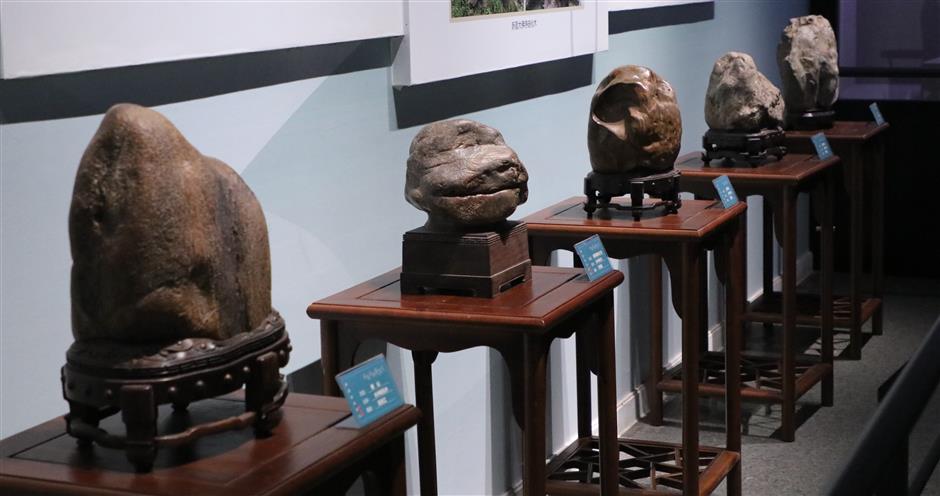Exhibition celebrates culture of Xinchang stone
Xinchang County in Zhejiang Province is a great place for hiking because of its lush vegetation, unspoiled creeks and oddly shaped mountains.
Its hills and terraced fields are mantled in mist, giving the appearance of a mysterious wonderland.
The county is also a mecca for stone connoisseurs. Due to unique geological changes over millions of years, Xinchang boasts a myriad of rare stone varieties that have attracted cavalcades of connoisseurs throughout history.
An ongoing exhibition at the Zhejiang Museum of Natural History shows the essence of Xinchang stones through October 9. Visitors could learn about ancient aesthetics and traditional stone culture from the exhibits on view.
Xinchang’s stone culture dates to the Southern and Northern Dynasty (AD 420-589), when scholars adopted a detached attitude toward life and yearned for seclusion. They celebrated secluded landscapes of hills and dales, pine trees of strange shapes and irregularly shaped stones.
From then on, Xinchang’s geological features attracted endless streams of literati. In the Tang Dynasty (AD 618-960), Li Bai, one of China’s greatest poets, visited Xinchang and left a poem eulogizing the majesty and beauty of Tianmu Mountain, which later developed into one of the most renowned literary works in the country.
The fame of Xinchang stones was widely spread under the influence of scholars. The trend of stone appreciation peaked during the Song Dynasty (960-1279), as evidenced by the displayed stones.

Xiangfu Yishi, one of the top-flight Xinchang stones, once belonged to Wang Yue, chancellor of the Southern Song Dynasty.
The highlight of the exhibition is petrified wood once set up in the garden of Wang Yue, chancellor of the Southern Song Dynasty (1127-1279).
As a Xinchang native, Wang was obsessed with stones and built a garden dotted with petrified wood and pines. This is believed to be the earliest garden of this variety in the country.
A classic Chinese garden is more than just a pretty facade outside a mansion. It is a statement about an inhabitant’s social status and reflection of their aesthetics.
Wang’s garden was destroyed during the following dynasties. Many of the stones disappeared into history, including the top-notch petrified wood piece known as Xiangfu Yishi.
The trail ran cold until 2003, when a local resident dug sand nearby the garden’s ruins and discovered an uncommon stone.
It weighs 250 kilograms, measuring 60 centimeters in length and 35 centimeters in width, coated with a layer of smooth texture, proving it had been rubbed by connoisseurs’ hands for centuries before being buried underground. Today, it still epitomizes top-flight Xinchang stones.

Petrified wood in the shape of a pine trunk
Another highlight is petrified wood transitioned from a pine trunk. All the organic materials of the trunk have been replaced with minerals, while retaining the original structure of the stem tissue.
Unlike other types of fossils that are typically compressions, this stone is a three-dimensional representation of the original organic materials, still remaining the shape of a pine trunk.
Xinchang people have long preferred original structures, textures, finish and natural patterns of stones rather than processed handicrafts.
When visiting the exhibition, visitors can see such original stones in garden and scholar’s rooms along with bonsais.
Stones and bonsais are two indispensable parts of ancient aesthetics.
They create miniature landscapes in small spaces.In essence, these items represent the beauty and power of the mountains in a small corner.
Xinchang County covers an area of 1,200 square kilometers with granite mountains in southeast, basalt plain in the middle, tuffaceous glutenite hills in northwest and crisscrossed watercourses.
In 2001, the local government built a petrified wood themed garden in Dafo Mountain, which has attracted flocks of stone connoisseurs from across the country.
The mountain is also noted for its tea culture and Buddhist grottos. Hikers can choose the safe stone-step path or pick their own way through the forest, exploring the area’s trails, streams, waterfalls and tea-related heritage.

A brush-modeled Xinchang stone on display

Different stone collections at the “Stone City” exhibition

Different stone collections at the “Stone City” exhibition
“Stone City” exhibition
Date: Through October 9, closed on Mondays
Address: Zone E, No. 6, West Lake Cultural Square
西湖文化广场6号E区
















